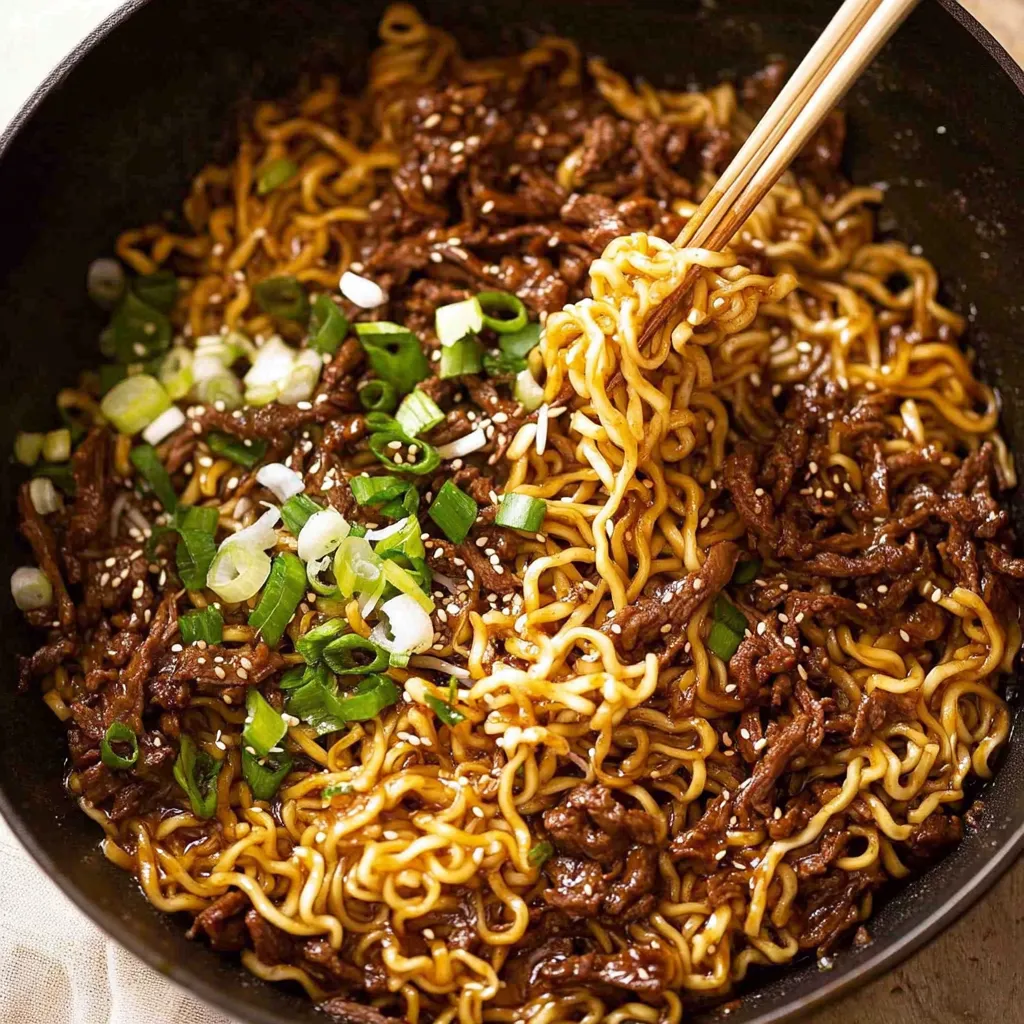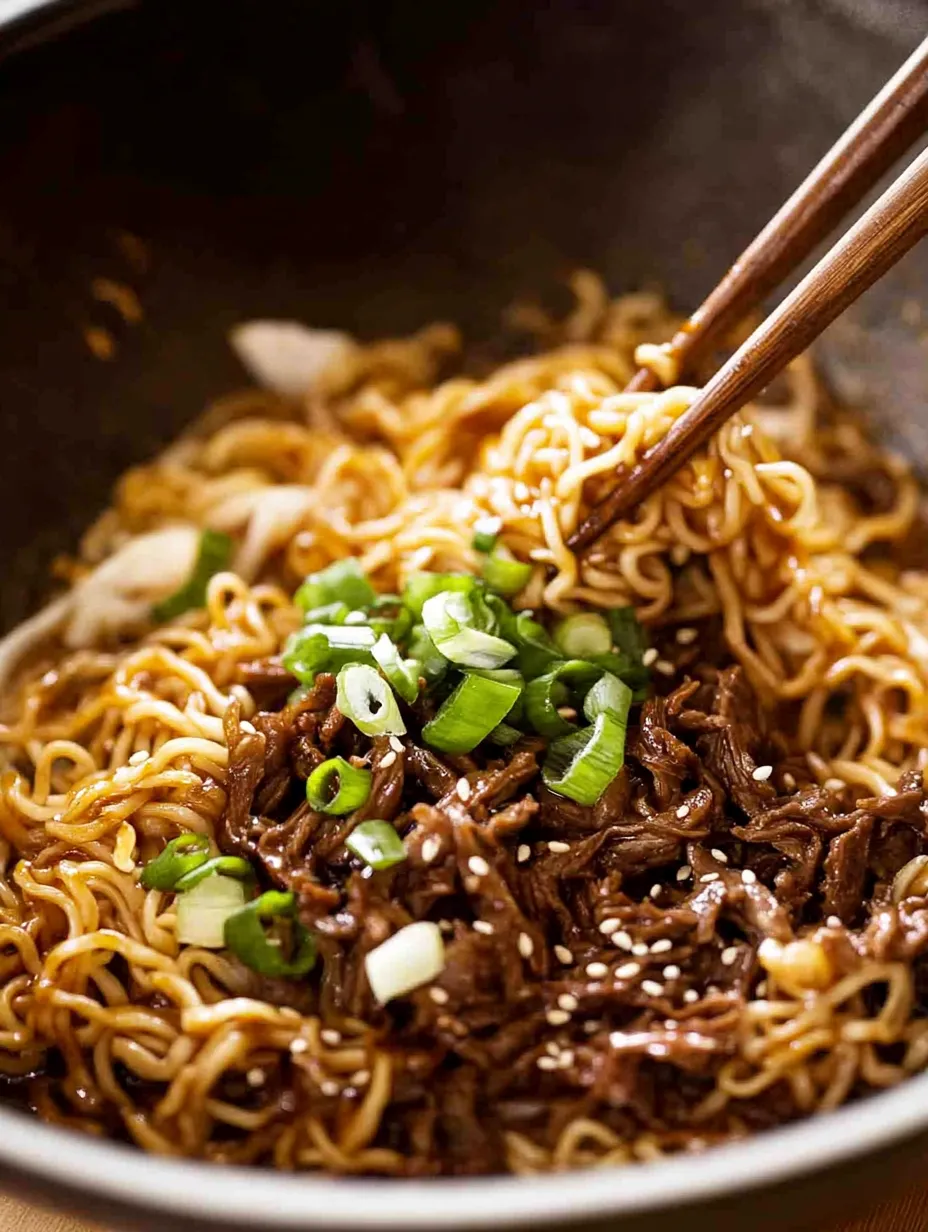 Save
Save
This quick Asian beef ramen noodle dish transforms ordinary instant noodles into an extraordinary meal in just 15 minutes. The secret lies in properly caramelizing the beef, which creates a rich depth of flavor that elevates this simple dish to restaurant quality. I created this recipe when looking for ways to upgrade pantry staples, and it quickly became my go-to option for busy weeknights.
I first created this recipe during a particularly hectic work week when I needed something fast yet satisfying. What started as a desperate pantry raid has become one of my most requested dinner recipes when friends come over for casual meals.
Ingredients
- Ground beef builds the foundation with rich savory flavor
- Dark soy sauce provides deep color and umami richness
- Oyster sauce adds complexity that makes this taste restaurant quality
- Sesame oil introduces that distinctive Asian aroma
- Instant ramen noodles cook directly in the sauce absorbing all the flavors
- Bean sprouts add fresh crunch and textural contrast
- Mirin balances the savory elements with subtle sweetness
Step-by-Step Instructions
- Sauce Preparation
- Combine dark soy sauce, oyster sauce, hoisin sauce, and mirin in a small bowl. This balanced sauce mixture creates the perfect harmony of sweet and savory flavors that will coat every strand of noodle. Taking a moment to mix this ahead ensures even distribution of flavors throughout the dish.
- Aromatics Foundation
- Heat both oils in a medium skillet over high heat until shimmering. Add onion and garlic, cooking for exactly 1.5 minutes until they begin turning golden but not brown. This aromatic base infuses the oil with flavor that will permeate the entire dish. Watch carefully as garlic can burn quickly at high heat.
- Beef Browning
- Add ground beef to the hot pan, breaking it into small pieces with your spatula. Cook until it changes from pink to light brown throughout, stirring frequently to ensure even cooking. Smaller pieces create more surface area for caramelization and better texture against the noodles.
- Caramelization Magic
- Pour the prepared sauce over the beef and cook for 2 to 3 minutes until well caramelized. This crucial step develops deep flavors as the sugars in the sauce react with the protein. The meat should look glossy and deeply browned with the sauce substantially reduced and clinging to the beef.
- Noodle Integration
- Push the caramelized beef to one side of the pan to create space for the noodles. Add water to the cleared area and place the dry noodle cakes directly into the water. This clever technique allows the noodles to cook in the same pan, absorbing all the flavor from the sauce and beef.
- Noodle Cooking
- Allow noodles to soak for 45 seconds before turning them over. After another 30 seconds, gently untangle them with chopsticks or a fork, then toss through the beef mixture. This gradual process prevents breaking the noodles while ensuring they cook evenly.
- Final Assembly
- Add bean sprouts and toss continuously for about 1 minute until the sauce reduces to perfectly coat the noodles and everything is thoroughly heated. The noodles should be tender but still have a slight bite. The bean sprouts will soften slightly while maintaining their refreshing crunch.

The dark soy sauce in this recipe is my secret weapon for depth of flavor. I discovered its transformative power during a cooking class in Singapore where the instructor explained that proper caramelization with dark soy creates that distinctive restaurant quality that home cooks often miss. Ever since, I never skip this crucial ingredient in my Asian noodle dishes.
Storage and Leftovers
This beef ramen keeps surprisingly well considering it contains noodles. Store leftovers in an airtight container in the refrigerator for up to 2 days. When reheating, add a tablespoon of water to loosen the sauce as the noodles tend to absorb liquid as they sit. Microwave gently at medium power, stopping to stir halfway through. The flavor actually deepens overnight making this possibly even better the next day.
Easy Substitutions
This recipe welcomes adaptations based on what you have available. Ground chicken or pork work beautifully in place of beef with minimal adjustments. Vegetarians can substitute crumbled firm tofu or tempeh that has been well pressed and browned. For the sauces, regular soy sauce can replace dark soy though the color will be lighter, and hoisin can fully substitute for oyster sauce for those avoiding seafood products.
Elevating Your Presentation
Transform this humble noodle dish into an impressive meal by focusing on presentation. Serve in deep bowls with chopsticks and a soup spoon on the side. Garnish with a generous sprinkle of sliced green onions, sesame seeds, and if you have them, a few drops of chili oil or sriracha swirled decoratively on top. The visual appeal of these simple additions makes diners feel like they are enjoying restaurant quality food at home.

Recipe FAQs
- → Can I use other types of noodles instead of ramen?
Yes, you can substitute with any fresh or dried noodles (rice or wheat). Simply prepare them according to package instructions, using about 2 packed cups, and toss them through the caramelized beef with a splash of water.
- → What can I substitute for the meat in this dish?
You can substitute ground beef with any other ground meat of your choice including chicken, turkey, pork, lamb, or even kangaroo. The cooking method remains the same regardless of which meat you choose.
- → What if I don't have mirin available?
If you don't have mirin, you can substitute it with Chinese cooking wine or dry sherry. For a non-alcoholic alternative, replace the 1¼ cups water with ½ cup water plus ¾ cup low sodium chicken broth and omit the mirin completely.
- → How can I make this dish vegetarian?
To make a vegetarian version, replace the beef with crumbled firm tofu or a plant-based ground meat alternative. Also, use vegetarian oyster sauce (now available in many supermarkets) and ensure your hoisin sauce is vegetarian-friendly.
- → How can I reduce the sodium content in this dish?
You can reduce the sodium by approximately 175mg per serving by using low-sodium soy sauce. Additionally, you could reduce the amount of soy and oyster sauces slightly and compensate with a bit more hoisin or a small amount of brown sugar to maintain flavor balance.
- → What vegetables can I add to make this more nutritious?
This dish is very adaptable to additional vegetables. Try adding thinly sliced bell peppers, snow peas, broccoli florets, or baby spinach. Add harder vegetables when cooking the onions, and more delicate vegetables like spinach just before serving.
